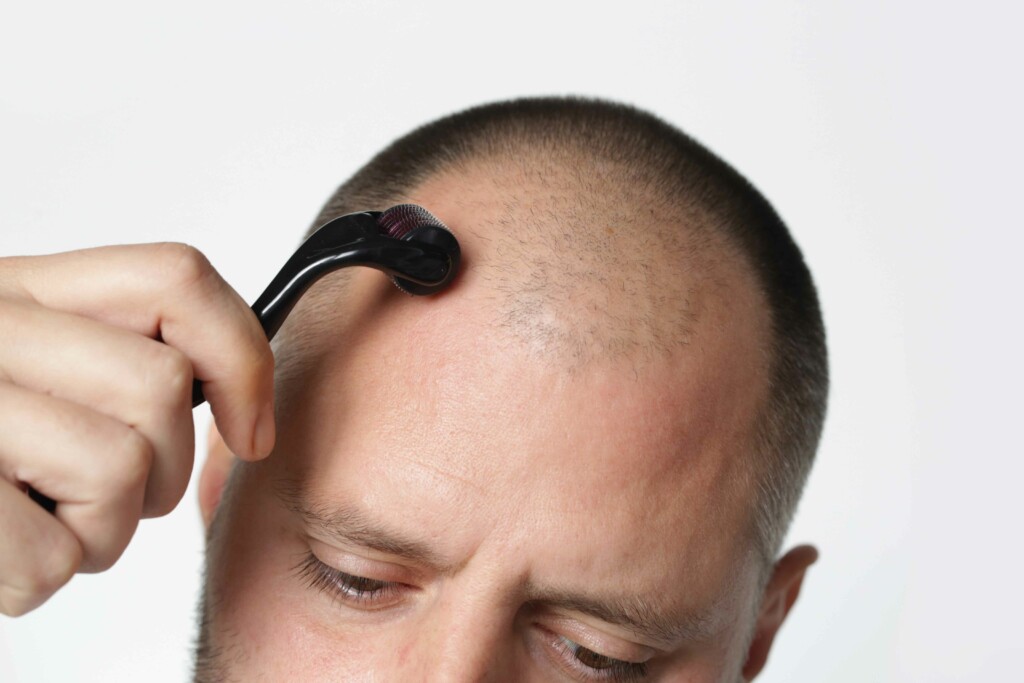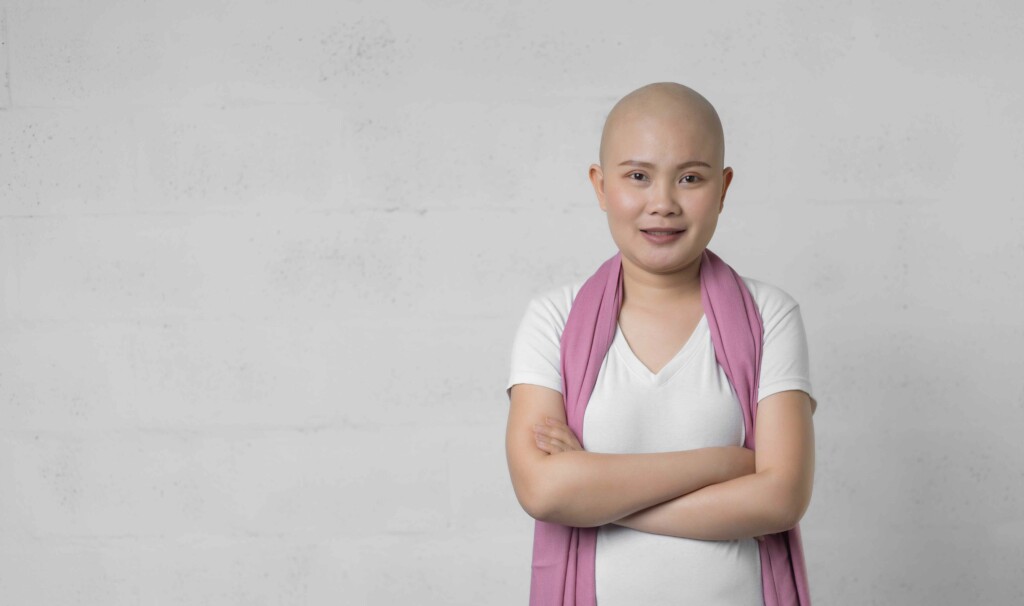Scarring alopecia, also known as cicatricial alopecia, refers to a form of hair loss that destroys hair follicles and damages the surrounding skin. There are many types of scarring alopecias, a number of which cause permanent hair loss as damaged hair follicles are unable to produce new hair strands. (1)
While these types of alopecia can be managed and their progression can be slowed, there is no cure available. Similarly, treatments to restore hair loss to areas of the scalp affected by scarring are limited.
Given the lack of treatment options available for people with cicatricial alopecias, a new clinical trial at Johns Hopkins is exploring a way to regrow hair in scarred regions of the scalp. This clinical trial is specifically trying to regenerate hair follicles in people with central centrifugal cicatricial alopecia, a form of scarring hair loss that primarily affects people of African descent. (2)
What Is Central Centrifugal Cicatricial Alopecia?
Central centrifugal cicatricial alopecia (CCCA) is a type of inflammatory, scarring hair loss. It is characterized by the inflammation and progressive destruction of hair follicles. Shortly after, the skin in this region is replaced by scar tissue, which results in permanent hair loss in the affected regions.
Who Does CCCA Affect?
CCCA primarily affects people of African descent and is the most common cause of hair loss in African Americans. CCCA primarily affects females between the ages of 30 and 55, but can also affect men and children. It’s estimated to have a prevalence of 3% to 6% but may affect up to 15% of Black women. (3,4)
CCCA is generally considered to be a multifactorial condition that is most likely to affect people with tightly curled or coiled hair. Bacterial and fungal infections, autoimmune issues, and hair care practices seem to play a role in the development of this condition. There’s also a gene variant that about a quarter of CCCA patients share, but its exact role in scarring alopecia is not yet known. (3,4)
What Does CCCA Look Like?
CCCA is a chronic and progressive condition that affects the central scalp region. The term “central” refers to the involvement of the central scalp region, while “centrifugal” describes the progressive pattern of hair loss that radiates outward from the central area. CCCA generally does not cause hair loss around the front, sides, or back of the scalp. (5)
CCCA tends to appear as hair thinning and breakage along the crown of the head or irregular patchy alopecia that may initially look like alopecia areata. It can also cause redness, irritation, tenderness, itchiness, burning sensations, scaly skin, and follicular pustules. (5)
What Are the Treatments for CCCA?
CCCA is often treated with topical steroids – especially if it’s caught early or the progression is mild. This at-home treatment may be applied once or twice a day, or a few times a week. It is sometimes combined with local corticosteroid injections performed every 4 to 8 weeks. Additionally, people with CCCA are encouraged to wash their scalps at least every week or two with an antifungal shampoo. Products like 1% ciclopirox shampoo and 2% ketoconazole shampoo can help reduce inflammation, itchiness, and scaly skin. (3-5)
In moderate or actively progressing cases of CCCA, oral antibiotics are often administered for several months, or until improvement is seen. If active inflammation is present, oral corticosteroids may also be used. Sometimes, immunosuppressants are also prescribed. (3-5)
If these treatments improve symptoms and stop the progression of CCCA, topical minoxidil (liquid or foam formulations) can be used to help boost hair regrowth and preserve the remaining hair follicles. In CCCA patients with more extensive hair loss, treatments like platelet-rich plasma therapy and hair transplantation can be considered if inflammation remains under control and progression stabilizes. (5)
Treating CCCA is important as this condition can have a significant psychological impact. Scarring hair loss is often associated with self-esteem and body image concerns. The visible scarring and progressive nature of CCCA can cause anxiety, depression, and social withdrawal. It is crucial to address these emotional aspects alongside medical treatment to support individuals dealing with CCCA.
Importantly, not everyone manages to get their CCCA to stabilize. In these cases, aesthetic solutions like the use of wigs, sprays, color sticks, crayons, and scalp micropigmentation are the main options available until the condition stops progressing. Patients who experience scaly skin and pustules tend to have higher odds of worsening CCCA. (8)
Can People With Scarring Alopecia Regrow Hair?
There are many types of scarring alopecia – and while all forms are challenging to treat, there have been many case studies reporting hair regrowth. However, scarring alopecia conditions can be grouped into three categories: lymphocytic, neutrophilic, and mixed. Currently, improvements in hair growth have primarily been reported in studies of people with lymphocytic forms of scarring alopecia, including (6):
- Central centrifugal cicatricial alopecia
- Discoid lupus erythematosus
- Lichen planopilaris
- Graham–Little syndrome (a rare variant of lichen planopilaris)
- Frontal fibrosing alopecia
- Follicular mucinosis
Hair regrowth of varying degrees has also been reported in individuals with dissecting cellulitis of the scalp, a type of neutrophilic cicatricial alopecia, and erosive pustular dermatosis of the scalp, a scarring alopecia that falls into the mixed category. (6)
Hair Regrowth in CCCA Patients
To date, there has been one small case report of two women with CCCA that described hair regrowth following treatment with topical metformin cream. Regrowth was attributed to the daily application of topical 10% metformin compounded in Lipoderm (a cream that improves absorption into the skin). Both cases featured women who had late-stage CCCA and had tried alternative treatments for years. (7)
In the first case, the patient was applying 5% topical minoxidil foam twice a day and using 0.05% topical corticosteroid ointment. She had also received eight cycles of corticosteroid injections and was taking Viviscal nutrient supplements. She discontinued the injections and minoxidil, then tried the 10% metformin cream. After about 6 months, her hair regrowth had improved substantially. (7)
In the second case, the patient was applying 5% topical minoxidil foam, 0.05% topical corticosteroid ointment, and topical 2% ketoconazole cream, and had also received five cycles of corticosteroid injections. She continued to use the minoxidil and receive corticosteroid injections and noticed improvement 4 months after adding metformin to her treatment regimen. (7)
While both of these women saw improvements in hair regrowth, neither of them experienced complete restoration of their original hair density. This would generally be considered to be impossible, as the scarred areas of their scalps contain damaged hair follicles that are no longer able to produce hair strands.
Regenerating Hair Follicles in CCCA Patients
The clinical trial at Johns Hopkins is taking a completely novel approach to regenerating hair follicles in people with CCCA. The team is using micro-wounding – administered using a fractionated carbon dioxide laser – in combination with retinoic acid to try to induce neogenesis. They hope that the creation of small surface-level wounds around damaged hair follicles will trigger cellular signaling that prompts cell regeneration – and the restoration of a fully functional hair follicle. Similarly, the application of retinoids aims to boost cell signaling. (2)
Currently, 20 men and women are being recruited for this clinical trial. It started in January 2018, but since it plans to run for a year for each patient, is only scheduled to finish in December 2025. (2)
If you have CCCA and are interested in participating in this clinical trial, you or your doctor may need to reach out to the team directly as they are currently only enrolling by invitation. You’ll also need to be 18 or older and have a clinical diagnosis of CCCA at a grade of 2, 3, or 4, but be otherwise healthy. (2)
References
- Scarring (cicatricial) alopecia: What it looks like & treatment. (2023) Cleveland Clinic.
- Johns Hopkins University. Study to Determine Effect of Gentle Wounding to Stimulate Hair Follicle Neogenesis (Clinical Trial Registration No. NCT03491267) clinicaltrials.gov
- Gabros, S., & Masood, S. (2022). Central centrifugal cicatricial alopecia. In StatPearls [Internet]. StatPearls Publishing.
- Aguh, C., & McMichael, A. (2020). Central centrifugal cicatricial alopecia. JAMA dermatology, 156(9), 1036-1036.
- Lawson, C. N., Bakayoko, A., & Callender, V. D. (2021). Central centrifugal cicatricial alopecia: challenges and treatments. Dermatologic Clinics, 39(3), 389-405.
- Poliner, A. D., & Tosti, A. (2021). Hair regrowth in cicatricial alopecia: a literature review. The Journal of Dermatology, 48(8), 1113-1128.
- Araoye, E. F., Thomas, J. A., & Aguh, C. U. (2020). Hair regrowth in 2 patients with recalcitrant central centrifugal cicatricial alopecia after use of topical metformin. JAAD Case Reports, 6(2), 106-108.
- Onamusi, T., Larrondo, J., & McMichael, A. J. (2023). Clinical factors and hair care practices influencing outcomes in central centrifugal cicatricial alopecia. Archives of Dermatological Research, 1-7.
Last updated February 2024




